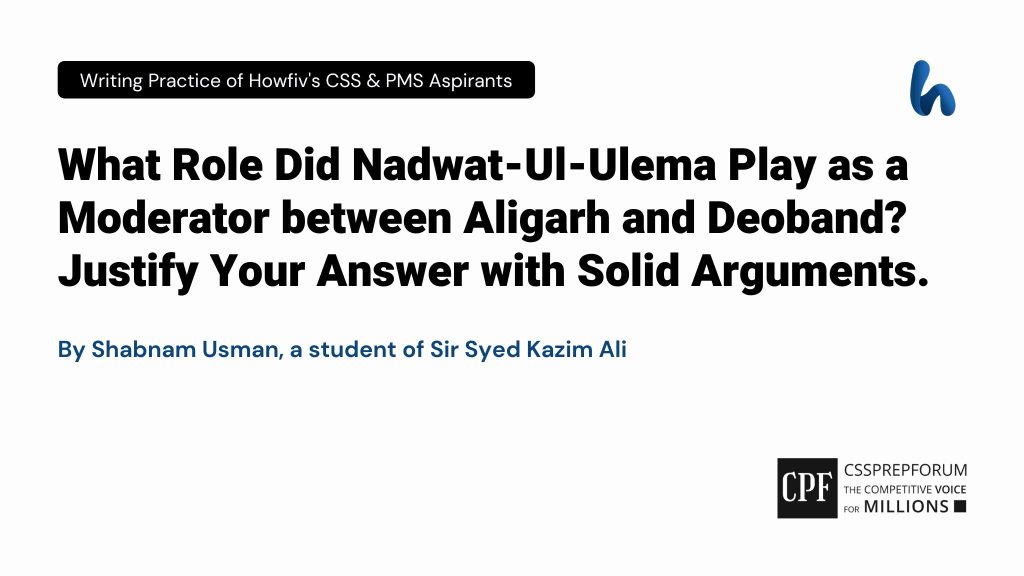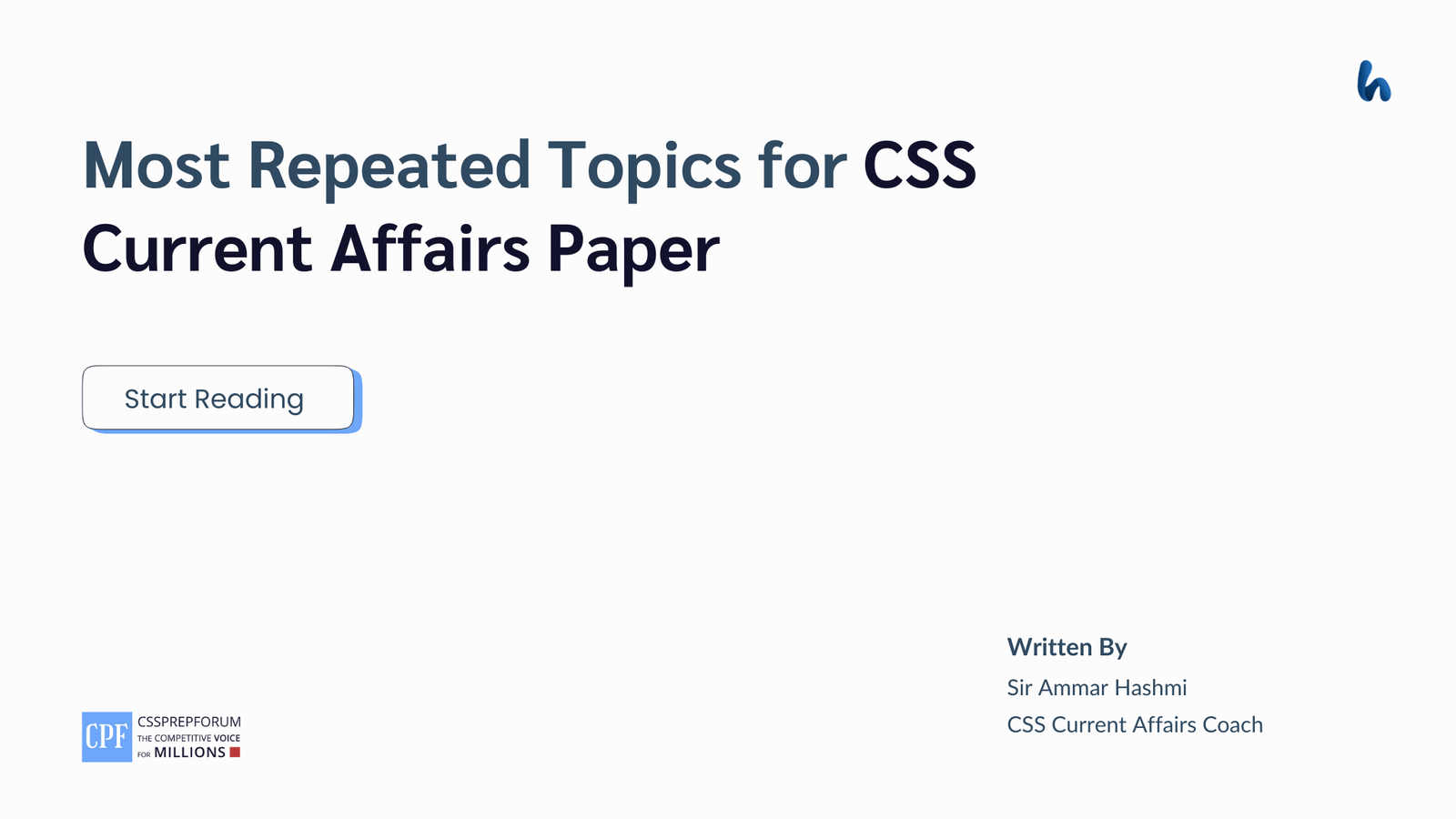The following article, “What Role Did Nadwat-Ul-Ulema Plays Moderator between Aligarh and Deoband? Justify Your Answer with Solid Arguments.“, is written by Shabnam Usman, a student of Sir Syed Kazim Ali. Moreover, the article is written on the same pattern, taught by Sir to his students, scoring the highest marks in compulsory subjects for years. Sir Kazim has uploaded his students’ solved past paper questions so other thousands of aspirants can understand how to crack a topic or question, how to write relevantly, what coherence is, and how to include and connect ideas, opinions, and suggestions to score the maximum.

Outline
1- Introduction
The advent of Nadwat-ul-Ulema has been considered an indispensable event in the history of the Muslims of the subcontinent as it effectively eroded the extreme conflicts and clashes between the existing educational movements of that time and preserved the Muslims’ identity in the region; in addition, it uplifted the status of the Muslims of the Indian subcontinent by protecting the Islamic culture, reviving religious teachings, and integrating modern and western education systems.
2- A brief overview of several educational movements for Muslims in the Indian subcontinent
3- How did Nadwat-ul-Ulema neutralize the differences between Aligarh and Deoband Movements?
- ✓It provided a moderate religious platform for Muslim scholars.
- Case in Point: The Nadwa movement was initiated by organizing a council of Muslim theologians in 1894 at Kanpur.
- ✓It integrated traditional religious curriculum with modern sciences.
- Case in Point: Nadwa’s Curriculum emphasized teaching the explanation of the Holy Quran, Islamic Jurisprudence, and modern philosophy and sciences.
- ✓It incorporated English language as a mandatory subject in addition to Arabic.
- Case in Point: English was taught alongside Arabic in educational institutes to curtail language barriers.
- ✓It resolved the conflicts between Ulema to preserve Islamic culture and restore Muslim unity.
- Case in Point: The annual conventions of Nadwat-ul-Ulema provided opportunities for Muslim scholars to present their diverse perspectives that effectively resolved their clashes.
4- Critical Analysis
5- Conclusion

Answer to the Question
Introduction
The magnificent wave that arose for the educational uplift of the Muslims of the subcontinent, seen right after the War of Independence, played a significant role in the lives of the Indian Muslims of that time. Among such initiatives, the most prominent ones were “The Aligarh Movement” and “The Deoband Movement”; they drastically reformed the Muslim community’s plight. Despite both movements aiming for the Muslims’ renaissance in the region, their approaches were opposite to each other, which initiated conflicts among Muslims. Under such conditions, there appeared the need for a moderate platform that not only tended to the reformational needs of the Muslim community but also nurtured unity. Therefore, Nadwat-ul-Ulema emerged as a silver lining in those circumstances. This movement rendered inimitable services for Muslims to bring them to the right path and simultaneously carry their religious principles and modern educational means. Furthermore, the Nadwa movement introduced a platform where the Muslims, whether following pro-religious thoughts or persuading pro-British views, got united and settled their issues effectively. It also inculcated the acceptance of the English language and Arabic in Muslim society to tackle the backwardness of language significantly and minimise the visionary gaps between Muslim scholars. This answer illuminates the Nadwa venture’s moderating role between the Aligarh and Deoband movements.
A brief overview of the establishment of several educational movements in India
The aftershocks of the 1857 War of Independence were so profound that they not only destroyed the social, political, and cultural fabric of the Muslims but also damaged the means of their religious education to introduce a new Western system of education that was unacceptable for the Muslims. To fulfil Muslims’ educational needs, Sir Syed Ahmed Khan stepped forward. He initiated the Aligarh movement, which, undoubtedly, was a splendid act by him to uplift the status of Muslims in India. However, he faced extreme criticism by the orthodox scholars of that time who entitled him ‘Pro-British”. As an alternative, some scholars introduced the Deoband movement to fill the religious gaps prominently seen in the Aligarh movement. Though both movements were working for the betterment of the Muslims, they followed extremely opposite views. Thus, to minimize their differences, another movement emerged known as the Nadwa movement. It successfully bridged the gaps between the former movements and served the Muslims in their overall prosperity and well-being.
Nadwat-ul-Ulema: A moderator between Aligarh and Deoband Movements
It provided a moderate religious platform for Muslim scholars.
Sir Syed Ahmad Khan’s goal behind the Aligarh movement was to familiarize Muslims with Western education to equalize their pace with other communities in the subcontinent and tilt them towards fulfilling society’s modern needs. On the other hand, the objectives of the Deoband movement were opposite to those of the Aligarh; it only aimed to revive the Islamic culture and religious norms by focusing solely on religious teachings. Hence, a gap was generated between the ideologies of the Muslims living in the same society. Fortunately, Molana Shibli Nomani sensed the need for a forum to align Islamic and Western education for Muslims. For this purpose, he organized a council of Muslim theologians in 1894 in Kanpur and highlighted the conflicts and the need to unite Muslim scholars by neutralizing their opposite views. So, Nadwat-ul-Ulema can surely be termed as a bridge between the two most significant yet controversial movements of that time.
It integrated traditional religious curriculum with modern sciences.
The Aligarh movement’s education mode was Western whereas the Deoband movement followed traditional educational techniques. Although religious teachings were also a part of the Aligarh movement’s curricula, they were not supposed to be promising enough. So, to fill this void, the Deoband movement entered the game and served the Muslims with a platform that specifically focused on religious and traditional education; however, it was also disadvantageous for the Muslims because it lagged behind in technology and modern literature. Consequently, the Nadwa movement reformed the traditional curriculum of Deoband and the modern methods of Aligarh and found a way between them. Therefore, the Holy Quran and Islamic Jurisprudence exegesis were taught at Nadwat ul Ulema with a touch of modern philosophy and science. Thus, the Nadwa movement effectively acknowledged and fulfilled the need to reform the existing curriculums to devise an all-rounder curriculum for Muslims in their practical lives.
It incorporated the English language as a mandatory subject in addition to Arabic.
The medium of instruction in the Aligarh movement was English so that the Muslims could easily adopt the Western culture and technological advancements of the British. On the other hand, the promotion of Arabic and Persian was the base of the Deoband movement for the efficient inculcation and propagation of cultural and religious thoughts in Muslim youth. Therefore, the language barrier was an ever-green issue of the educational societies of the Indian subcontinent; consequently, Nadwat-ul-Ulema considered the escalating issue of the medium of institutions very divinely and instilled the English language as a compulsory subject along with Arabic to fulfil the needs of that era. Hence, the English language ensured the excellence of Muslims in modern science and Western studies whereas Arabic helped them master Islamic education.
It resolved the conflicts between Ulmas to preserve Islamic culture and to restore Muslim unity.
To promote and flourish the Muslim society in the subcontinent, there was an urgent need for consensus among the ‘Great Intelligentsias’ of the Muslim community. However, the scholars from different sects were extremely disintegrated due to their diverse ideologies and schools of thought. The scholars that were more exposed to the Western culture used to promote Westernization for the uplift of the Muslims; contrarily, the orthodox scholars adopted religious extremism to ensure the protection of traditional literature while neglecting the modern requirements of that time. Such opposing perspectives of the Muslim Ulemas gave birth to extreme ideological clashes in the Muslim community. Here again, Nadwat-ul-Ulema served as a joint platform for all the scholars. The institute invited Muslim scholars from different schools of thought to moderate and merge their views for the revival of Muslims and Islamic culture in their annual conventions. In conclusion, Nadwat-ul-Ulema provided an intermediate way to educate Muslims in all domains of their lives while uniting them.
Critical Analysis
To critically analyze the whole debate, the main reason behind establishing Nadwat-ul-Ulema was the preservation of the Islamic culture that was vanishing because of the expansion of Westernization in education institutes. Thus, there was a dire need to balance both the religious and Western forms of education, successfully entertained by the Nadwa movement. Although the Aligarh and the Deoband movements hold great importance in the pages of history, it would not be wrong to say that without the initiation of the Nadwa movement, the former movements would have disintegrated the Muslim society into two blocks: The Moderns and the Extremists.
Conclusion
To encapsulate the story, multiple education movements evolved after the War of Independence; each was based on different visions and outlooks, but Nadwat-ul-Ulema can be said to have efficiently bridged the differences among all those movements. It aimed to provide a single platform to fulfil all kinds of educational needs of Muslim society. Moreover, the Aligarh and the Deoband movements had efficiently served to uplift the Muslims in their possible purviews, either by imposing Westernization or traditionalist approaches, but the advent of Nadwat-ul-Ulema has acted as a cherry on the cake. It enhanced the beauty and influence of those movements by merging their prominent and significant elements. The idea dissolved the conflicts, promoted Muslim unity, and preserved the Islamic culture and education. Hence, the Nadwa movement played a crucial role as a moderator between two extremes: The Aligarh movement and the Deoband movement.

CSS Solved Past Papers’ Essays
Looking for the last ten years of CSS and PMS Solved Essays and want to know how Sir Kazim’s students write and score the highest marks in the essays’ papers? Then, click on the CSS Solved Essays to start reading them.
CSS Solved Essays
CSS Solved General Science & Ability Past Papers
Want to read the last ten years’ General Science & Ability Solved Past Papers to learn how to attempt them and to score high? Let’s click on the link below to read them all freely. All past papers have been solved by Miss Iqra Ali & Dr Nishat Baloch, Pakistan’s top CSS GSA coach having the highest score of their students. General Science & Ability Solved Past Papers
Articles Might Interest You!
The following are some of the most important articles for CSS and PMS aspirants. Click on any to start reading.












